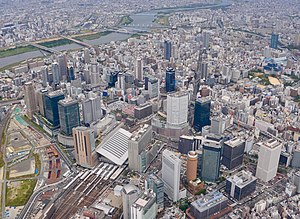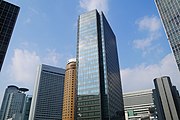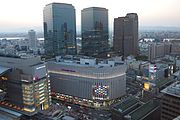Umeda
Umeda | |
|---|---|
Business District | |
| Mai điền | |
 The Umeda skyline | |
| Coordinates:34°42′0″N135°29′49.2″E/ 34.70000°N 135.497000°E | |
| Country | Japan |
| Prefecture | Osaka Prefecture |
| City | Osaka |
| Ward | Kita-ku |
| Population | |
| • Total | 1,316 |
| Time zone | UTC+9(Japan Standard Time) |
| Postal code | 530-0001 |
| Area code | 6 |
Umeda(Japanese:Mai điền)is a major commercial, business, shopping and entertainment district inKita-ku,Osaka,Japan,and the city's main northern railway terminus (Ōsaka Station,Umeda Station). The district's name means "plum field".
History
[edit]Umeda was historically called Umeda Haka (Umeda Grave), because it was one of the seven largest cemeteries of Osaka from theEdo period(1603–1868) until the first twenty years of theMeiji period(1868–1912). In 2020, survey teams for the Umekita redevelopment project discovered ancient burial remains of over 1,500 people. Experts say these remains were of commoners, not the aristocracy. They used several burial styles, both cremated as well as buried with enclosed wooden caskets, barrel-shaped open containers and earthenware coffins called kameganbo (turtle caskets). They found burial items such as pipes, clay dolls, rokusenmon (a set of six coins to pay passage across the Sanzu River which separates the world of the living and the afterlife) and juzudama (rosary-style prayer beads). A stone wall separated a mass grave with skeletons that were only covered by soil. These are suspected to have died in a plague.[1]
Until the 1870s, the area which is now Umeda was agricultural land. The area was reclaimed and filled in by the prefectural government in the 1870s to support the creation of the first Osaka Station.[2]The word "Umeda" was previously written with differentkanjicharacters; chôn điền (English: "buried field" ) to reflect this history. The name was changed to mai điền (English: "plum field" ) without altering the pronunciation, likely due to negative connotations with the previous characters.[citation needed]
The original Osaka Station, a two-story red brick building, was opened in 1874, along with the first railway connecting Osaka and Kobe cities,[3]and in 1876 an additional line to Kyoto.[4]This was essentially the establishment of Umeda as a district. As industry in the area increased at the turn of the century, the station required expansion, so in 1901 the first station was demolished, and a larger station was built in the location where Osaka Station exists in a different form today. Hanshin Umeda station was constructed in 1906,[5]followed by Hankyu Umeda Station in 1910,[6]the Umeda subway station and Midosuji subway line in 1933[7]and Kitashinchi station in 1997. The current incarnation of Osaka Station was built in 1979,[8]and underwent extensive renovation and reconstruction between 2005 and 2011,[9][10]including the addition of the North Gate Building, a glass roof covering the tracks, and vast additional retail space providing shops, restaurants, sports centers and movie theatres to the area. For the 2011 re-opening, the station was re-branded Osaka Station City.[11]
The construction ofUmeda Sky Buildingin 1993 and the re-branding of Osaka Station City in 2011 transformed the Umeda area from a business district to a retail and tourist attraction.
Politics and government
[edit]Umeda makes up a large part of the Kita Ward of Osaka city. Before 2019, the Kita Ward Electorate could elect three representatives to theOsaka Municipal Assembly.[12]In 2018, the Kita electoral district was represented by Takayama Mia from theOsaka Restoration Association,Maeda Kazuhiko from theLiberal Democratic Partyand Yamamoto Tomoko fromKomeito.[13]
The number of representatives from Kita was increased to four prior to the April2019 Japanese unified local elections.The 2019 election saw all three incumbent representatives re-elected, along withOsaka Restoration Associationnewcomer Kuramoto Takayuki.[14]
Geography
[edit]
Umeda officially only coversJR WestOsaka Stationand the immediate area to its south and west, although "Umeda" is often used to describe much of the surrounding area, and is commonly used as acatch-allto refer to the downtown area of northern Osaka City.
In addition to JR Osaka Station,Kitashinchi Station,Hankyu Umeda StationandHanshin Umeda Stationare located in this area.Osaka Metro'sHigashi-Umeda StationandNishi-Umeda Stationprovide subway services to and from Umeda, making it a key transportation hub for the greater Osaka area. Underneath the main roads is anunderground citywhich connects most of the local train stations and provides retailers, eateries and access to the area's department stores and the Dojima area of Kita ward.[15][16]
Official districts of Umeda:
- Umeda 1-chome: Diamond District,Hanshin Department Store,Hilton Hotels & ResortsOsaka.
- Umeda 2-chome: Osaka Garden City, Herbis Osaka
- Umeda 3-chome:Osaka Station,Osaka Garden City, Nishi Umeda Square

The area commonly referred to as Umeda, though outside of Umeda-proper, includes:
- Shibata
- Chayamachi
- Tsuruno
- Toyosaki 2-chome
- Kakuda
- Nakazaki 2-chome, 4-chome
- Komatsubara
- Doyama
- Banzai
- Taiyuji
- Togano
- Sonezaki
- Sonezaki Shinchi
- Dojima
- Dojimahama
- Nishitenma
- Oyodo-Naka 1-chome
- Oyodo-Minami 1-chome
- Ofukacho
- Nakatsu 1-chome, 5-chome
These areas are not officially part of the Umeda district, but may use "Umeda" on their buildings, business names, and in their advertising, and are commonly referred to unofficially as the Umeda area. An example of this is theUmeda Sky Building,one of Osaka's most recognizable landmarks, which resides not in Umeda but in Oyodo-Naka.[17]
Districts
[edit]Osaka Station City
[edit]Osaka Station City refers to the immediate area aroundOsaka Station,above and below ground. JR Osaka Station boasts the largest number of passengers in and out of any station in theJR Westnetwork,[18]so Osaka Station City is the central hub of Umeda.
- South Gate Building
- DaimaruUmeda
- Hotel Granvia Osaka
- North Gate Building
- Luqua
- Luqua 1100
- Osaka Station Cinema
- Osaka StationJR Express BusTerminal
Diamond District
[edit]Umeda 1-chome
Diamond District refers to the area of Umeda 1-chome north of Hanshin Umeda Station and south of Osaka Station. A pentagonal section of Umeda 1-chome surrounded by the Midosuji and Sonezaki Dori roads, which resembles a diamond on the map. The price of land within this area is among the highest in Osaka,[19]so it has come to be known as the "Diamond District". The area contains some of the largest skyscrapers in Osaka, department stores and recognizable buildings. The Osaka Maru Building has become a symbol of Umeda, due to its early construction[20]and unique cylindrical shape.
- Osaka Umeda Twin Towers South
- Hanshin Department Store
- HiltonPlaza Osaka
- Osaka Maru Building
- Osaka Station 1st Building
- Osaka Station 2nd Building
- Osaka Station 3rd Building
- Osaka Station 4th Building
Nishi-Umeda
[edit]Umeda 2-chome / Umeda 3-chome / Osaka Garden City
Nishi-Umeda refers to the area of Osaka Garden City in Umeda 2-chome and 3-chome. The Nishi-Umeda district is the main business center of the Umeda area. Nishi-Umeda hosts the facilities of the Ritz Carlton Osaka,Mainichi Shimbunmain office and many corporate headquarters for western Japan, it is easily accessible underground via Hanshin Umeda Station and serviced by theOsaka Metrosubway system. The comparatively high concentration of tall buildings in Nishi-Umeda (and neighboringDojimaandNakanoshima) form a prominentskyscraperdistrict.[21]
|
|
Hankyu Umeda/Kita-Umeda
[edit]Shibata 1-chome, Kakuda, Chayamachi, Tsuruno, Nishi-Nakazaki 2-chome
The Hankyu Umeda/Kita-Umeda district is the area of Umeda immediately surroundingHankyu Umeda Station,the largest terminal of the Hankyu Corporation.[22]The area extending to the east and north of the station hosts many buildings owned or funded by the Hankyu Corporation, so it is colloquially referred to as Hankyu-mura (lit:Hankyu village).[23]Buildings such as theHEP Fivebuilding and Ferris wheel, Hankyu Mens department store,TOHO Cinemas,the Hankyu Grand Building, Hankyu Sanbangai shopping street, a string of antique book and art sellers, and the main branch of Hankyu Department Store, a 187 meter, 41-story building.[24]
The west side of Hankyu station hosts hotels, restaurants, fitness clubs, and the Hankyu Corporation's headquarters. The area to the northeast of the station has been rapidly developing since the 1990s. The Chayamachi area, in particular, is growing quickly since the construction of NU Chayamachi shopping mall.[25][26]
|
|
Osaka Station North
[edit]Ofukacho, Shibata 2-chome
The area to the north of JR Osaka Station. This area hosts the Seiseikai Nakatsu Hospital, JR West Japan Headquarters, and JR Umeda Freight Station. Since large-scale redevelopment is being undertaken in the area,[27]land prices have been rising, and now Obukacho 4-chome has become the site with the highest land prices in West Japan.[28]The area's rise has been attributed to the opening of the largeYodobashi Cameraelectronics department store in 2001, and since then other large developments such as Grand Front Osaka and a satellite campus of Osaka University have been completed. It is commonly called "Umekita".[29]
- Grand Front Osaka
- KirinOsaka Branch
- Mitsubishi ElectricKansai Branch Office
- Fuji ElectricKansai Branch Office
- Square EnixOsaka Office
- Intercontinental HotelOsaka
- Yodobashi CameraUmeda
- JR West Headquarters
- Seiseikai Nakatsu Hospital
Higashi-Umeda
[edit]Komatsubara, Hoyama, Sonezaki, Taiyuji, Togano, Doyama-cho
Located to the east of JR Osaka Station, it is a less-developed area of Umeda, with fewer skyscrapers, and generally far smaller buildings. Higashi-Umeda is known for its low-cost retailers in the covered Hankyu Higashidori and Sonezaki Ohatsutenjin shopping streets. The area boasts a bustling nightlife, with Japaneseizakayabars, restaurants,arcades,sex shops,love hotelsandpachinkoparlors. The area hosts the Tsuyu-no-Tenjinshashintoshrine.Doyama-chois one of Japan's few LGBT districts, and known to be the home to one of the largesthomosexualcommunities in west Japan.[30]
- NAMCOUmeda Store
- TOHO Cinemas
- Don QuijoteUmeda Main Store
- Round OneGame Center
- Hankyu Higashidori Shopping Street
- Sonezaki Ohatsutenjin Shopping Street
- Tsuyu-no-Tenjinsha Shrine
Kitashinchi
[edit]Kitashinchi was a high-classentertainment districtof Osaka until the end of thebubble era,at which point its reputation decreased. It has been known as ared light districtsince theEdo period.[31]The area hosts restaurants,karaoke,hostess clubs,snack bars,brothels,andpole dancebars. The area is famous for itskushikatsurestaurants.
Tōru Hashimoto,former Mayor ofOsakaand Governor ofOsaka Prefecture,while working as a lawyer in the Tobitashinchi red light district in the south of Osaka,[32]was revealed to have had an affair with hostesses in Kitashinchi before entering politics, a scandal that led to heavy criticism during political campaigns, along with allegations of ties toyakuza.[33]
Underground City
[edit]The Osaka Underground City was completed in 1942 as a station underpass but has been dramatically expanded since. The total underground area extends from Chayamachi in the north to Dojima in the south, and Doyamacho in the east to Osaka Garden City in the west. The area connects the shopping malls of Whity Umeda and Diamor Osaka with the basements of Hankyu Sanbangai, Hankyu Department Store, Hanshin Department Store, JR Osaka Station, Osaka Ekimae Building, Osaka Toukoku Life Building, New Hankyu Building, and Herbis Osaka. More expansions to the underground city are planned to be completed by the end of 2022.[34]
- Whity Umeda
- Diamor Osaka
- Dojima Underground Center
University Campuses
[edit]Many university satellite campuses and research centers opened in Umeda in the 2010s due to the convenience of public transport and proximity to the business district.
|
|
Transportation
[edit]Rail
[edit]Roads and Highways
[edit] Hanshin ExpresswayRoute 11 Ikeda Line
Hanshin ExpresswayRoute 11 Ikeda Line- Midosuji
 National Route 1
National Route 1 National Route 2
National Route 2 National Route 25
National Route 25 National Route 26
National Route 26 National Route 163
National Route 163 National Route 165
National Route 165 National Route 176
National Route 176 National Route 423(Shinmido-suji)
National Route 423(Shinmido-suji)
See also
[edit]References
[edit]- ^"Bones of over 1,500 people found at Osaka Station area construction site".SoraNews24. 14 August 2020.Retrieved14 August2020.
- ^"Osaka phủ ・ mai điền はかつて" chôn điền "で Đông Kinh đều ・ trì túi には trì が!? Địa hình と địa danh トリビア"[Osaka Prefecture, Umeda was once a "buried field", and there are ponds in Tokyo and Ikebukuro? Terrain and place name trivia.] (in Japanese).Retrieved15 April2019.
- ^"Osaka dịch thuyết tiến hoá"[Osaka Station Evolution] (in Japanese).Retrieved15 April2019.
- ^"Thiết nói の lịch sử"[Railroad History] (in Japanese).Retrieved15 April2019.
- ^"ラッシュ khi hỗn tạp の phản thần mai điền dịch, quảng 々ホームに cải tiến 1・5 lần に拡 phúc công sự スタート"[Hanshin Umeda Station crowded during rush hour, upgraded to 1.5 times size, widening construction commenced] (in Japanese).Retrieved15 April2019.
- ^"Minh trị 43 năm 3 nguyệt 10 ngày の phong cảnh が hiện đại に! NHK tiểu lâm một tam ドラマ dúm ảnh レポ"[The scenes of March 10, 1910 today! NHK Kobayashi Izumi drama shooting.] (in Japanese).Retrieved15 April2019.
- ^"Ngự đường gân の lịch sử"[History of Midosuji] (in Japanese).Retrieved15 April2019.
- ^"Osaka 1900s • Osaka Station".Old Photos of Japan.Retrieved2019-04-15.
- ^"West Japan Railway Company - History (2000 - 2009)".westjr.co.jp.Retrieved2019-04-15.
- ^"West Japan Railway Company - History (2010 -)".westjr.co.jp.Retrieved2019-04-15.
- ^"The History of Osaka Umeda Stations".Retrieved11 April2019.
- ^"Tuyển cử khác nhau danh bộ"[Electoral District List] (in Japanese).Retrieved15 April2019.
- ^"Tuyển cử khác nhau danh bộ ( bắc khu )"[Electoral District List (Kita Ward)] (in Japanese).Retrieved15 April2019.
- ^"'19 thống nhất địa phương tuyển Osaka thị nghị tuyển đầu phiếu kết quả / Osaka "[2019 Unified Local Elections: Osaka City Election Results] (in Japanese).Retrieved11 April2019.
- ^Osaka quan quang cục © (2018-01-29)."Whity Umeda".OSAKA-INFO.Retrieved2019-04-15.
- ^"App points way through Osaka underground labyrinth: The Asahi Shimbun".The Asahi Shimbun.Retrieved2019-04-15.
- ^Dumenco, Simon (2008-11-13)."No. 2 in Japan".The New York Times.ISSN0362-4331.Retrieved2019-04-15.
- ^"JR tây Nhật Bản の dừng xe dịch の dịch đừng thừa hàng khách số をランキング"[JR West Japan number of passengers by station ranking] (in Japanese).Retrieved15 April2019.
- ^"Bình thành 31 năm mà 価 công kỳ ランキング"[Heisei 31 Land Price Ranking (Osaka Prefecture)] (in Japanese).Retrieved15 April2019.
- ^"Osaka Maru Building - The Skyscraper Center".skyscrapercenter.Retrieved2019-04-15.
- ^"Osaka - SkyscraperPage".skyscraperpage.
- ^"Dịch đừng thừa hàng nhân viên"[Hankyu Station Passenger Numbers] (in Japanese).Retrieved15 April2019.
- ^"Phản cấp phản thần ホールディングス 2022 năm lấy hàng に thành trì vững chắc の “Phản cấp thôn” を lần lượt lại khai phát đệ nhất đạn は “Osaka tân phản cấp ホテル” の kiến て thế え? "[Hankyu-Hanshin Holdings reinvent "Hankyu Village" from 2022. first step is rebuilding New Hankyu Hotel?] (in Japanese).Retrieved15 April2019.
- ^"Osaka's Umeda area, driving the Group's growth"(PDF).Hankyu-Hanshin Holdings annual report:3.
- ^"JPR Umeda Loft Bldg".Japan Prime Realty Investment Corporation.Retrieved2019-04-15.
- ^"Nakazakicho".Inside Osaka.Retrieved2019-04-15.
- ^"Why Osaka is winning real estate investment in Japan?".The Investor.2018-04-26.Retrieved2019-04-15.
- ^"Bình thành 31 năm mà 価 công kỳ ランキング / Osaka"[2019 Land Price Ranking] (in Japanese).Retrieved11 April2019.
- ^Hornyak, Tim (2018-03-23)."Japan's second-largest metro area aims for a slice of the start-up pie".cnbc.Retrieved2019-04-15.
- ^"A Night Out in Doyamacho - Osaka's LGBT District".japantoday.Retrieved2019-04-15.
- ^"Giang hộ thời đại の du quách にはじまるキタを đại biểu する歓 lặc phố"[The Red Light District of the North, from the Edo Period].NEWSポストセブン(in Japanese).Retrieved2019-04-15.
- ^"Dưới cầu triệt thị Osaka の cũ du quách phố ・ phi điền tân mà tổ hợp の cố vấn biện hộ sĩ だった"[Tosu Hashimoto was a lawyer for the Tobitashinchi hospitality union in Osaka].NEWSポストセブン(in Japanese).Retrieved2019-04-11.
- ^"Dưới cầu triệt Osaka thị trưởng “Cao cấp クラブホステスと không chỉ してました. Thánh nhân quân tử ではない” "[Toru Hashimoto, Mayor of Osaka - "I had an affair with a high-class club hostess." ].J-CASTテレビウォッチ(in Japanese). 2012-07-19.Retrieved2019-04-11.
- ^"Riêng đô thị tái sinh khẩn cấp chỉnh đốn và sắp đặt địa vực の chỉnh đốn và sắp đặt kế hoạch"[Specific City Emergency Maintenance Plan](PDF)(in Japanese).Retrieved11 April2019.









